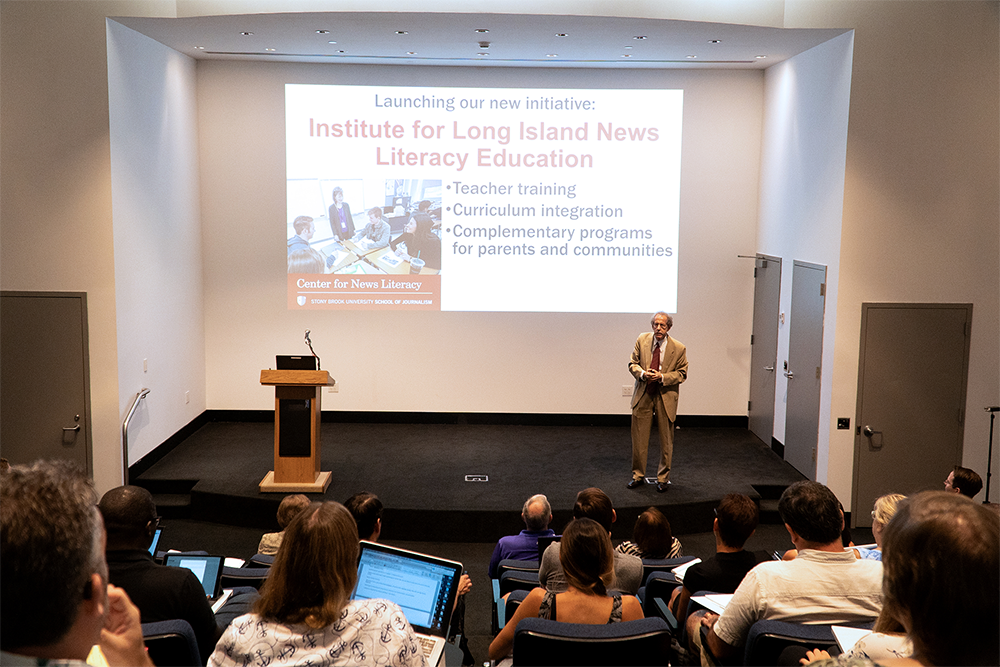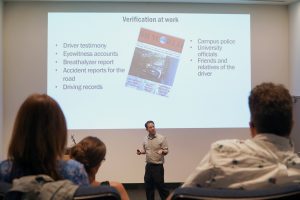
STONY BROOK, N.Y. – July 31, 2019 – At a time of unprecedented concern about the spread of false and misleading news, the Stony Brook University School of Journalism’s Center for News Literacy brought together 36 teachers from 15 Long Island school districts for an interactive, three-day workshop that equipped them with the skills and tools to teach the center’s proven and widely-praised News Literacy curriculum to their students – as young as 11 – this fall.
The News Literacy Summer Academy, which took place July 22-24 at Stony Brook University, is part of a broader initiative recently launched by the center to help the region’s school districts adapt the university’s undergraduate curriculum for K-12 students. The Academy was made possible, in part, by support from the Rauch Foundation and the Bethpage Federal Credit Union.
Under the initiative, the Long Island Institute for News Literacy Education, the center is partnering with select districts, including Plainview-Old Bethpage Central School District, to integrate News Literacy skills into required instruction and create complementary programs for parents and families.

Center for News Literacy Assistant Director Jonathan Anzalone discusses verification 2019 Summer Academy at Stony Brook University July 22. Photo by Valentine Edwards/JTL Entertainment
“We are facing a public health emergency, and the solution won’t be better technology, or even more penetrating and transparent journalism, however beneficial,” said Howard Howard Schneider, the founder and executive director of the Center for News Literacy. “It will be teaching students at an early age how to interrogate news and information. It needs to start early and be reinforced in order to be effective.”
Schneider added that he hopes the initiative will help make Long Island a leader in the state and nation in preparing the next generation of news consumers and citizens.
“We have some terrific schools with innovative leaders who can lead the way,” he said.
Since the Center’s creation in 2007, its pioneering curriculum, designed to teach students how to use critical thinking skills to judge the reliability of news and information, has been taught to more than 15,000 Stony Brook students, at more than two dozen other U.S. universities and in 10 countries.
The middle school and high school educators at the July academy heard from fellow teachers whom have already utilized the center’s curriculum in their classrooms, were welcomed by New York State Regent Roger Tilles and heard from Dr. Sam Wineburg of Stanford University, whose research has found alarming deficits on the part of current students to evaluate reliable sources online. Jane Lytvynenko, a BuzzFeed News journalist who reports on online disinformation, delivered the keynote address.
Participants also worked together to create their own News Literacy lessons that they’ll be able to bring back to their classrooms in September.
Glenn Hadzima, a high school English teacher from South Country Central School District, was a second time attendee. Hadzima previously attended an academy in 2011.
“I like the idea that the kids will use actionable materials” Hadzima said. “Things won’t be abstract … it will be real world stuff.”
AnnMarie Jenkins, a middle school librarian from the Northport-East Northport Union Free School District, said she has long taught source evaluation, and the academy showed how important those lessons are and how she can put them into practice.

Participants at the 2019 Summer Academy at Stony Brook University July 22 work together to create News Literacy lessons. Photo by Valentine Edwards/JTL Entertainment
“I have to fit it in with the real world because I’ve been standing up there preaching, “you have to look at where it is coming from,”” Jenkins said. “Now it all makes sense.”
Jonathan Anzalone, assistant director of the Center for News Literacy, said he believes the Academy will generate enthusiasm among educators for News Literacy and the potential of the curriculum to have a transformative effect on student learning.
“Our hope is that participants will leave the Academy feeling as if they are part of a community and support network of News Literacy educators who will share ideas and resources, and continue to spread News Literacy and amplify its impact on students,” Anzalone said.
Funding by the Rauch Foundation also will enable the center’s new Institute to support in-depth work by two partner or “lighthouse” districts in the coming academic year. Districts will receive $35,000 to support teacher training, curriculum writing, an assessment plan and development of a community program. Plainview-Old Bethpage is the first partner district, while a second district will be chosen in the fall.
“Our team is excited to work alongside Stony Brook to create News literacy curriculum for students in grades 7-12, and an elective course where our high school students can earn college credit, “said Dr. Mary O’Meara, assistant superintendent for curriculum at Plainview- Old Bethpage. “This grant permits us to create a comprehensive program that also includes a parent and community component. The entire school community recognizes the timeliness of this work."